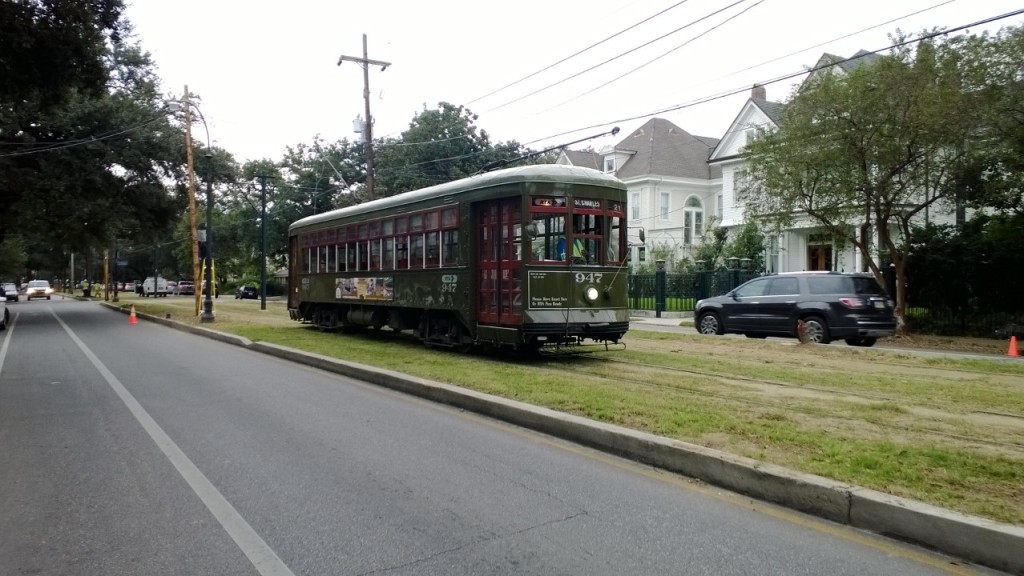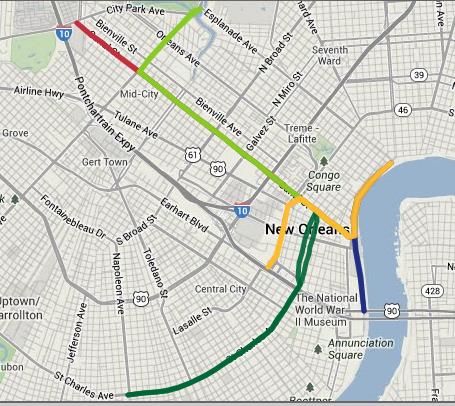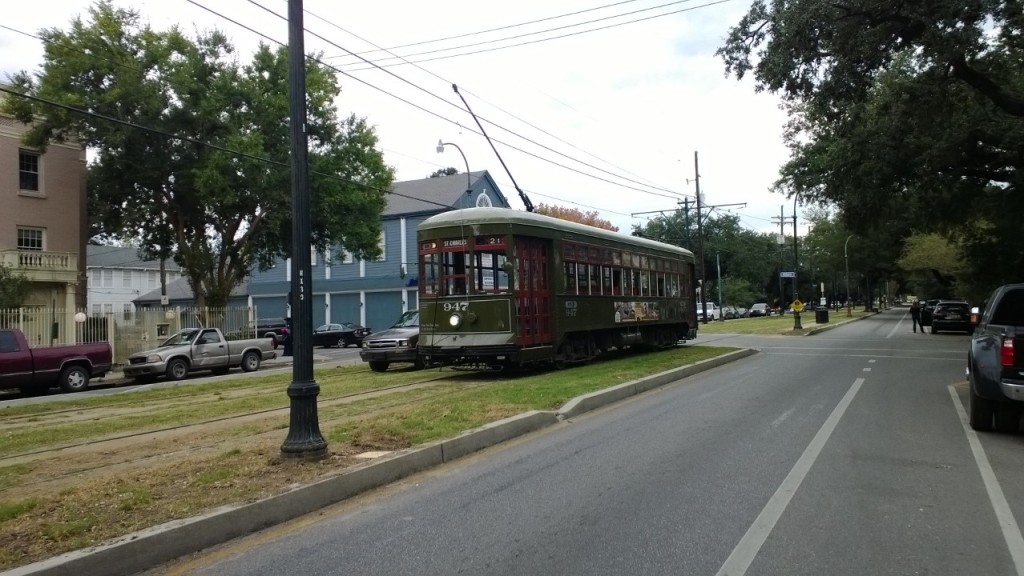 Our latest student-written story comes from John Owens, a political science student at Tulane University in New Orleans.
Our latest student-written story comes from John Owens, a political science student at Tulane University in New Orleans.
By John Owens
Streetcars are as much a part of New Orleans as beignets, Mardi Gras and the New Orleans Saints. Rolling down the most well-known streets in the city, the unmistakable whir of their electric power and sound of the old-fashioned suspension fills the air for blocks around. The wooden seats hark back to a time when craftsmanship ruled over mass-production. Streetcars are an institution here.
Recently, the New Orleans Regional Transit Authority (RTA) has poured millions into revitalizing the aging rails that underpin the system. It tore up track bit by bit, starting before the 2013 Super Bowl and continuing through now. It is the kind of investment that implies a commitment to a long future with the streetcar in New Orleans.
In the run up to the Super Bowl, the RTA even added a 2.8 mile spur with 13 stops. It took less than a year to complete, an unusually quick project by New Orleans standards.
With streetcars running down more streets and on better tracks, it begs the question: are streetcars a viable transit solution, a tourist attraction or both?
When the expansion was announced in 2011, Mayor Mitch Landrieu emphasized that the new line was being added so the streetcar can better serve the community. “The Regional Transit Authority continues to improve services to better meet the needs of our residents,” Landrieu stated. “This expansion brings streetcars back into our neighborhoods, providing affordable and reliable transportation to a large segment of our community. This expansion represents a viable new mode of transportation that reconnects us to our rich history and heritage.”
My experience riding streetcars leads me to believe they are both a tourist attraction and a viable transit solution.
 There are five main lines that run through New Orleans. They do not run where a majority of the population resides or serve the lower income populations who may not be able to afford a car. Instead, they run through the businesses and tourist attractions downtown as well as major landmarks throughout the city.
There are five main lines that run through New Orleans. They do not run where a majority of the population resides or serve the lower income populations who may not be able to afford a car. Instead, they run through the businesses and tourist attractions downtown as well as major landmarks throughout the city.
As a student at Tulane University, I have easy access to the St. Charles streetcar line. This line runs from downtown through uptown, conveniently stopping at the front of Tulane’s campus among other places.
When I lived on campus at Tulane, I frequently utilized the streetcar as my method of transportation to get downtown. Whether it was for a Hornets or Saints game, a night in the French Quarter or going to services at a synagogue far from campus, the streetcar was my primary mode of transportation. It got me where I needed to go.
However, that was about the extent of my streetcar riding. The streetcar is slow, notoriously so. The service provided is infrequent and often comes in bunches. It gets you where you need to go, but not easily. Another downside is that the streetcar runs on a reduced schedule late at night. This proved especially problematic for trips downtown or to the French Quarter when I would not be coming home until late in the evening. As the wait for the streetcar grew long, we would grow impatient and hail a cab to get home.
The snail-like pace of the streetcar prevented me from taking it any further than downtown. If I wanted to go to City Park, New Orleans’ iconic green area, it would take me upwards of an hour on the streetcar, not including the wait for the next car after changing lines downtown.
This, compared to the 20-30 minutes on my bike, seemed an eternity. The areas it served also forced me to bike instead of taking the streetcar. When I went to a speech at Xavier University, far from any streetcar service, I rode my bike.
 But the languid speed of the streetcar was, at times, a benefit. I had time to think, relax and take in all of the beauty of New Orleans. The St. Charles line runs through arguably the most beautiful areas of the city and really experiencing that every once in a while was an immense pleasure.
But the languid speed of the streetcar was, at times, a benefit. I had time to think, relax and take in all of the beauty of New Orleans. The St. Charles line runs through arguably the most beautiful areas of the city and really experiencing that every once in a while was an immense pleasure.
Moreover, you can put the windows up on the streetcar, allowing every bit of fresh air you would like in. I know I’m not the only one who enjoyed the pace from time to time. Sarah Williams, a senior at Tulane University from Denver, is another streetcar rider.
“Before I brought my car down to New Orleans, I used the streetcar almost any time I wanted to go anywhere outside of walking distance,” Williams said. “The stop at Tulane’s campus was really convenient and I didn’t mind the slow ride because I love watching the people and the mansions pass by. I even worked downtown for a couple of months and would use the streetcar to get to and from work.”
She went on, “The unpredictable frequency of the streetcar has been my biggest issue. Especially when I was coming home from working at a restaurant downtown by myself at 1 AM, I wished the streetcar came more often. It was sometimes unnerving to wait by myself for an hour surrounded by rowdy tourists and locals.”
Most New Orleanians will tell you that they don’t ride the streetcar once they can drive. They ride the bus or drive. They will tell you that it is too slow, that it is not convenient and that they have better options. All of this is true. New Orleanians would rather drive than take the streetcar; even in the slowest traffic, they’ll still get where they’re going faster.
Yet, for some young New Orleanians, there is nothing better than riding the streetcar to and fro. Uday Nandipati, a Tulane senior and New Orleans native, did not ride the streetcar much as a boy, although his brother did.
“[I] didn’t really use it [the streetcar] that much but my brother either took the streetcar or the bus to school every day when we were little,” said Nandipati. “It’s still a viable transit option, especially downtown or St. Charles where the streets are either really congested or really bad. At this point, it’s for both locals and tourists.”
The 2012 Comprehensive Operational Analysis for the New Orleans Regional Transit authority, the most recent data on ridership available indicates that the streetcar lines accounted for roughly 18,000 of the roughly 47,000 boardings within the entire system. That’s just over 38 percent of all riders.
The St. Charles and Riverfront streetcar lines were also the third and fourth most productive transit lines the city runs as well, averaging 46 and 48 boardings per hour respectively. Furthermore, the Canal and St. Charles streetcar lines were “regularly operating over capacity during select times of day. All of this indicates that the demand is ever present for the streetcar lines.
According to the report, two of the three operating lines owed much of their ridership to the tourist market. The St. Charles line can thank its historic streetcars, while the Riverfront line is targeted toward the tourist market, according to the report. This tells us that though the streetcar lines are running at a high capacity, they are hardly serving the residents of New Orleans effectively.
It is hard to imagine New Orleans without its beloved streetcars. Movies have featured them, advertising campaigns have highlighted them and tourists flock to them. The streetcar moves people, albeit slowly, to the most well-known places in the city. There are more effective transit solutions in New Orleans without a doubt.
As the data has shown, few of those who would typically ride public transportation use the streetcar. New lines, serving more of the city, should help serve some of the community. The city government seems to believe that this will be the case.
But the streetcar serves a purpose greater than just moving people. It is an iconic piece of Americana that embodies the slower pace of New Orleans. It is a tourist attraction, it is a transit option and with reinvestment from the city it will continue moving riders to and from New Orleans’ most iconic places.
